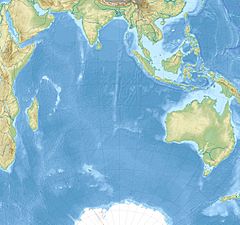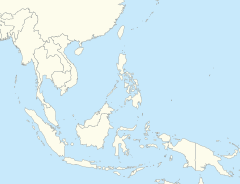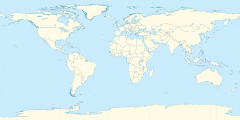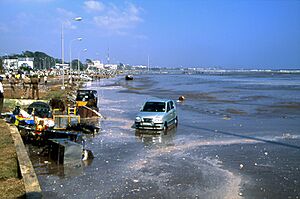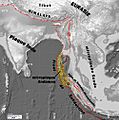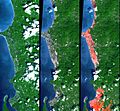2004 Indian Ocean earthquake and tsunami facts for kids
- 2004 Indian Ocean
- earthquake and tsunami
Quick facts for kids 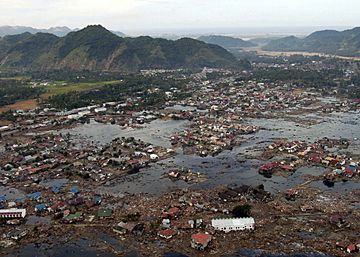
South-west suburb of Banda Aceh, Sumatra. Taken on 2 January 2005 by US Navy
|
|
| UTC time | 2004-12-26 00:58:53 |
|---|---|
| ISC event | 7453151 |
| USGS-ANSS | ComCat |
| Local date | 26 December 2004 |
| Local time | |
| Magnitude | 9.1–9.3 Mw |
| Depth | 30 km (19 mi) |
| Epicentre | 3°18′58″N 95°51′14″E / 3.316°N 95.854°E |
| Type | Megathrust |
| Areas affected | Indian Ocean coastline areas |
| Max. intensity | IX (Violent) |
| Tsunami |
|
| Casualties | 227,898 dead |
The 2004 Indian Ocean earthquake and tsunami was a very powerful underwater earthquake. It is also known as the Sumatra-Andaman earthquake. This huge event happened on December 26, 2004, at 00:58:53 UTC.
The earthquake's starting point, called the epicenter, was off the west coast of Sumatra, Indonesia. Scientists first measured its strength as 9.0 on the Richter scale. Later, they updated it to a massive 9.3. This makes it one of the strongest earthquakes ever recorded in modern times. Only the Great Chilean Earthquake of 1960 was more powerful.
This earthquake was also the longest ever recorded. It lasted between 500 and 600 seconds, which is about 8 to 10 minutes. It was so strong that it made the entire Earth vibrate. It even caused other earthquakes as far away as Alaska.
Contents
What Was the Asian Tsunami?
The huge movement of the Earth under the ocean caused a very large and powerful tsunami. A tsunami is a series of giant ocean waves. This one was often called the Asian tsunami. In some countries like Australia, Canada, England, and South Africa, it was known as the Boxing Day tsunami. This is because it happened on Boxing Day.
The tsunami spread across the entire Indian Ocean. It caused a lot of damage to many countries. These included Malaysia, Thailand, Indonesia, and Sri Lanka. It also greatly affected the eastern coast of India, in states like Tamil Nadu and Andhra Pradesh.
The waves were incredibly high, some reaching up to 30 meters (100 feet). These powerful waves caused many deaths and destroyed a lot of buildings and other property. Over 227,898 people died or went missing because of the tsunami. The waves even caused high water as far away as East Africa. In South Africa, about 8,000 km (5,000 mi) away, 8 people died due to the high water.
Because of the huge amount of damage and the many people affected, over $7 billion (USD) was donated. This money helped to rebuild the areas that were damaged.
How Did the Tsunami Affect Nature?
Besides the terrible loss of human lives, the Indian Ocean earthquake and tsunami also had a huge impact on the environment. This impact will affect the region for many years. Reports showed severe damage to important ecosystems. These include mangroves, coral reefs, forests, and coastal wetlands.
Other natural areas like sand dunes and rock formations were also harmed. The variety of plants and animals, known as biodiversity, was affected. Even groundwater supplies were damaged. The spread of trash, chemicals, and water pollution made the environmental problems even worse. It will take a long time and a lot of effort to fully understand this damage.
Experts say that one of the main problems was the fresh water and soil becoming salty. This happened because saltwater from the ocean flowed inland and left a layer of salt on the land. Soil that becomes salty cannot grow plants easily. It is also very hard and expensive to make it good for farming again. This salt also causes plants and tiny living things in the soil to die. Thousands of rice, mango, and banana farms in Sri Lanka were almost completely destroyed. It will take years for them to recover.
What Was the Economic Impact?
The amount of damage to the economy from the tsunami depended on the area. Overall, the impact on entire countries was not as big. However, local economies in the affected areas were completely ruined. The two main jobs that suffered the most were fishing and tourism. Many fishing boats were destroyed, and tourist areas were badly damaged.
Images for kids
-
The tsunami's propagation took 5 hours to reach Western Australia, 7 hours to reach the Arabian Peninsula, and did not reach the South African coast until nearly 11 hours after the earthquake
-
Baiturrahim Mosque survived the tsunami in Ulee Lheue, banda Aceh
-
Flooding in George Town, Malaysia
-
Chennai's Marina Beach after the tsunami
See also
 In Spanish: Terremoto del océano Índico de 2004 para niños
In Spanish: Terremoto del océano Índico de 2004 para niños


